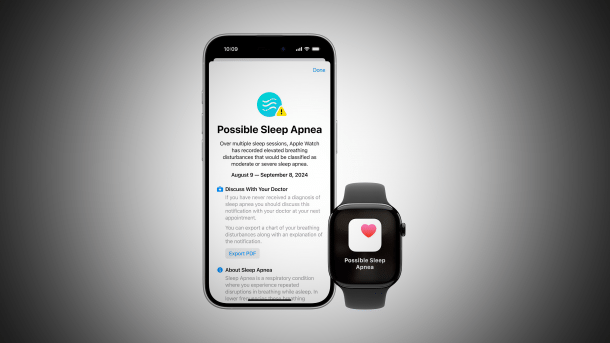Detection of sleep apnea via Apple Watch: feature is activated
The Food and Drug Administration in the USA allows Apple to use the Watch to detect respiratory arrest at night. The feature is active in many countries.

Sleep apnea function in the Apple Watch: Notification of incidents.
(Image: Apple)
Apple has also released a new health function in its computer watch this week with watchOS 11. Sleep apnea tracking during the night is available on the new Apple Watch Series 10, which will be released on Friday, as well as on older models. Approval from the US Food and Drug Administration (FDA) was also granted this week.
China and India not included
The freshly updated list of countries receiving the new feature is long: there are 150 regions in the world in one fell swoop, including the EU countries, Switzerland, Liechtenstein and Norway. At first glance, however, Apple's important future market of India, the People's Republic of China (except Macau and Hong Kong), Australia, Canada and Taiwan are the biggest "omissions" – It is still unclear when approval will be granted here.
Commendably, owners of Apple Watch Series 9 and Ultra 2 (both from 2023) can also use tracking. Earlier models such as the first-generation Ultra or the Series 8 and SE are excluded. Sleep apnea detection is part of Apple's sleep tracking. It first monitors the user's condition over a certain period of time and can then report whether breathing pauses occur during the night, are "increased" or not. Apple has validated its system in a clinical study and uses "advanced machine learning".
Why sleep apnea is a problem
Sleep apnoea occurs millions of times and is unfortunately rarely even realized by those affected. Depending on the severity of the condition, short or longer interruptions in breathing occur with varying frequency due to physiological factors. Poor oxygen saturation at night can have serious long-term consequences – ranging from organic damage to increased susceptibility to dementia and heart attacks. Some sufferers also experience dangerous microsleep during the day. Type 2 diabetes and high blood pressure are also promoted.
The Apple Watch does not use the blood oxygen sensor for tracking, which is the subject of a patent dispute, but the watch's very sensitive acceleration and motion sensor. Data on wrist movements is collected for at least 30 nights. A notification is then sent if necessary. Very mild cases of sleep apnea cannot be tracked.
Empfohlener redaktioneller Inhalt
Mit Ihrer Zustimmmung wird hier ein externer Preisvergleich (heise Preisvergleich) geladen.
Ich bin damit einverstanden, dass mir externe Inhalte angezeigt werden. Damit können personenbezogene Daten an Drittplattformen (heise Preisvergleich) übermittelt werden. Mehr dazu in unserer Datenschutzerklärung.
(bsc)